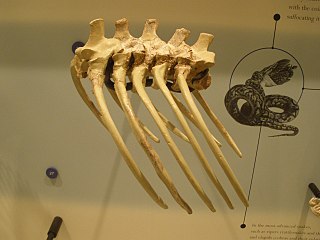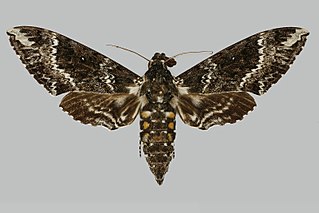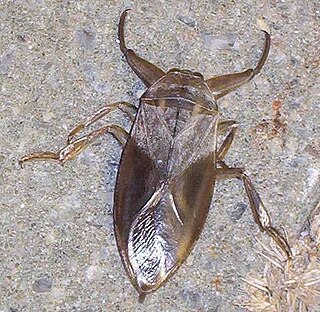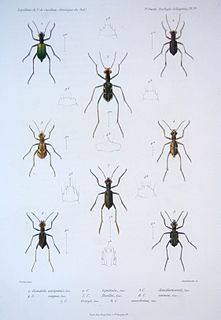
Metatheria is a mammalian clade that includes all mammals more closely related to marsupials than to placentals. First proposed by Thomas Henry Huxley in 1880, it is a slightly more inclusive group than the marsupials; it contains all marsupials as well as many extinct non-marsupial relatives.

Wall spider is the common name for members of the genus Oecobius. The members of these several species are all very small spiders that make small flat webs over crevices in walls and in similar spaces. They possess an organ called a cribellum, which is a kind of comb-like device used to separate fibers of silk drawn from its spinnerets into many extremely fine fibers. Those fibers are so small in diameter that prey insects easily become entangled in them. The spiders then bite them before they can get away.

Manduca is a genus of moths in the family Sphingidae, the hawkmoths. The genus is used as a model in the biological sciences. The tobacco hornworm and the tomato hornworm in particular have been well studied. The genus was erected by Jacob Hübner in 1807.
Listrura is a genus of pencil catfishes native to South America.

Madtsoiidae is an extinct family of mostly Gondwanan snakes with a fossil record extending from early Cenomanian to late Pleistocene strata located in South America, Africa, India, Australia and Southern Europe. Madtsoiid snakes include very primitive snakes, which like extant boas and pythons would likely dispatch their prey by constriction, such as Gigantophis, one of the longest snakes known at an estimated 10.7 metres (35 ft), and the Australian Wonambi and Yurlunggur. As a grouping of basal forms the composition and even the validity of Madtsoiidae is in a state of flux as new pertinent finds are described.

Manduca camposi is a moth of the family Sphingidae. It is known from Ecuador.

Madtsoia is an extinct genus of madtsoiid snakes. It is known from the Eocene of Argentina, the Paleocene of Brazil, the Late Cretaceous (Campanian) of Spain, the Late Cretaceous of India, and the Late Cretaceous (Maastrichtian) of Madagascar and the Coniacian of Niger. Recovered vertebrae of M. pisdurensis are 1.83 centimetres (0.72 in) long and 4.35 centimetres (1.71 in) tall) and pertain to a snake that was approximately 5 metres (16 ft) long.
Trematochampsidae is an extinct family of mesoeucrocodylian crocodylomorphs. Fossils are present from Madagascar, Morocco, Niger, Argentina, and Brazil. Possible trematochampsids have been found from Spain and France, but classification past the family level is indeterminant. The trematochampsids first appeared during the Barremian stage of the Early Cretaceous and became extinct during the late Maastrichtian stage of the Late Cretaceous.

Lethocerus is a genus of the hemipteran family Belostomatidae, known colloquially as giant water bugs, distributed in tropical, subtropical and temperate areas of the world. The greatest diversity of species occurs in the Americas, with only a single species in Europe, two in Africa, two in Australia and three in Asia. It includes the largest true bugs with species capable of reaching a length of over 12 centimetres (4.7 in). The South American L. grandis and L. maximus are the only species to commonly exceed 9 cm (3.5 in), with more typical lengths for the remaining species being between 4.5 and 9 cm. Lethocerus sp. are distinguished from other genera in the Lethocerinae by two symmetrical furrows in the inner pad of setae on the fore femur, the external borders of parasternites II and III narrowed and nearly straight, and with the setae of the tarsomeres following the line of the tibial setae.
Chileseius is a genus of mites in the Phytoseiidae family.
Pseudolampetis is a genus of beetles in the family Buprestidae, containing the following species:

Odontocheila is a genus of beetles in the family Carabidae, containing the following species:
Barreirosuchus is an extinct genus of trematochampsid notosuchian known from the Late Cretaceous of São Paulo State, southeastern Brazil. It contains a single species, Barreirosuchus franciscoi. It is most closely resembles Caririsuchus camposi from the Araripe Basin and Itasuchus jesuinoi also from the Bauru Basin, and shares with them several synapomorphies.
Tetracha camposi is a species of tiger beetle in the subfamily Cicindelinae that was described by W. Horn in 1900.

Phyllogomphoides is a genus of dragonflies in the family Gomphidae. They are commonly known as leaftails. It contains the following species:
Aenictus gutianshanensis is a Chinese species of army ant in the genus Aenictus. The species is known only from a single colony. Little is known about its biology, but it is probably most closely related to A. vieti.
Haliplus camposi is a species of Haliplidae in the genus Haliplus. It was discovered in 1948.
Peruveleon is a genus of antlions in the family Myrmeleontidae. There are about five described species in Peruveleon.
Psilocurus is a genus of robber flies in the family Asilidae. There are about 14 described species in Psilocurus.
Calyptraeotheres is a genus of pea crabs in the family Pinnotheridae.







